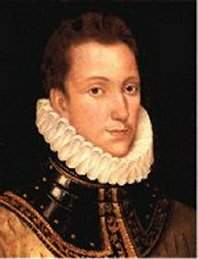|
 |
 |
 |
| Sir Philip Sidney |
| ��Q���D�u�o����h |
| �Ϥ��ӷ��Ghttp://www.i-way.co.uk/~sid/thesidneys.html#philip1 |
| �D�n�����GPoem |
| ��ƴ��Ѫ̡GCecilia Liu/�B���� |
| ����r���GSonnet Sequence;Sonneteer;English Literature:the Sixteenth Century;English Literature and Culture
From Medieval Period to the Eighteenth Century
|
|
|
|
|
Sir Phillip Sidney
1554�V1586
|
|
|
| �@ |
| History has portrayed Phillip Sidney as a prodigy.
As his friend Fulke Greville wrote, "though I knew him from a child,
yet I never knew him other than a man, . . . his very play tending to
enrich his mind, so that even his teachers found something in him to
observe and learn above that which they had usually read or taught."
Play�Xunderstood in the Renaissance manner as "serious play"�Xtook up
much of Sidney's early career. Leaving Oxford at the age of seventeen
but without a degree, Sidney embarked on what in later centuries was
known as the Grand Tour. He visited Europe's major cities, seeking men
and women who were fashioning the political goals and aesthetic
sensibilities of the age. They included the philosopher Hubert Languet,
whose Protestantism was linked to a fiercely antityrannical politics;
the artists Tintoretto and Paolo Veronese, whose luminous realism was
to determine painterly style for more than a generation; and, finally,
Henry of Navarre (later King Henry IV of France) and his wife, Margaret
of Valois, whose reign would see the worst of the religious wars in
Europe. Back in England by 1575, Sidney espoused a politics that
challenged authority. Siding with his father, Henry Sidney, Queen
Elizabeth's Lord Deputy Governor of Ireland, he argued for imposing a
land tax on the Anglo-Irish nobility, citing their "unreasonable and
arrogant pretensions" as a cause of civil unrest. And in 1580, seeking
to protect the monarchy from foreign influences, he wrote to the Queen
cautioning her against a match with Francis, Duke of Alençon and
brother to the French king, Henry III. She was furious at his temerity
and ordered him to the country, where he was to remain out of touch
with court affairs. By 1584 she had relented, sending Sidney to the
Netherlands to assess the Protestant resistance to Spanish rule. There,
in 1586, fighting for the Queen's interest and the Protestant cause she
championed, he died of an abscessed bullet wound in his thigh. |
| �@ |
�@ |
| Sidney's first literary work was a brief pastoral
masque entitled The Lady of May, composed in
honor of the Queen in 1578. His subsequent exile from court provided
him with extensive time to write. He was often at Wilton, the estate of
his sister, Mary Herbert, Countess of Pembroke; it was there that he
wrote the first two of his major works, in all likelihood with his
sister and her circle as his first readers and critics. The
Apology for Poetry, a work defending what Sidney called his
"unelected vocation," answers attacks on art, poetry, and the theater
by such censorious writers as Stephen Gosson. But its argument exceeds
the limits of antitheatrical debate to embrace questions about the uses
of history and the effectiveness of philosophy�Xa subject that bears
comparison with the poetics of Aristotle and Horace. Readers have
remembered most its insistence that "poetry" goes beyond nature to
fashion an ideal; it works "not only to make a Cyrus, which had been
but a particular excellency as nature might have done, but to bestow a
Cyrus upon the world to make many Cyruses." Poetry's creatures�Xwhether
heroes, heroines, or villains�Xcannot misrepresent fact because they
exist only in the imagination of readers and listeners: "for the poet,"
Sidney declared, "he nothing affirms, and therefore never lieth." |
| �@ |
�@ |
|
(Source: Addison Wesley and Benjamin
Cummings)
(external)
English Literature I: the Sixteenth
Century Litrature
|
| �@ |
�@ |
| �@ |
�@ |
�@ |
�@
|
|
|
|
